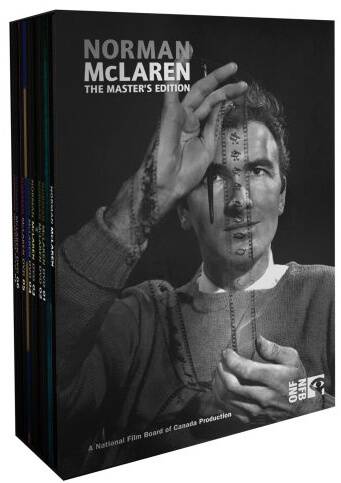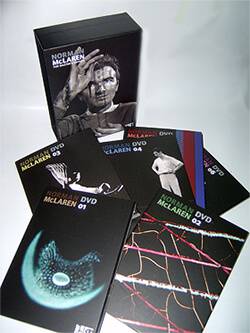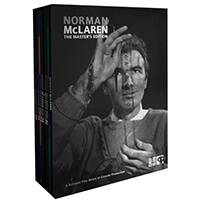Norman McLaren: The Master’s Edition
 With the great Norman McLaren’s 100th ‘birthday’ having passed last week, centenary celebrations have already begun in Canada and Scotland and are set to carry on throughout the summer. While there are a multitude of screenings, installations, apps, documentaries and events focused on the man’s fabulous, fascinating and game-changing output, for the purposes of this piece I’m turning my attention toward what’s fast becoming a more humble medium – the DVD box set. The wealth of critical analyses focused on McLaren’s films is so comprehensive as to make any contributions I might have on the subject largely moot. It is safe to say I am hugely enamoured of the work and awestruck by how much the brightest figures of today’s animation scene (and beyond) are so clearly indebted to his ingenuity and inspiration. The risk in getting started on my personal appreciation for his filmography is that there’s simply no way to put it across in one article. As such, the main intent of this piece is reviewing the effectiveness of Norman McLaren: The Master’s Edition as a means to both present and represent a body of work.
With the great Norman McLaren’s 100th ‘birthday’ having passed last week, centenary celebrations have already begun in Canada and Scotland and are set to carry on throughout the summer. While there are a multitude of screenings, installations, apps, documentaries and events focused on the man’s fabulous, fascinating and game-changing output, for the purposes of this piece I’m turning my attention toward what’s fast becoming a more humble medium – the DVD box set. The wealth of critical analyses focused on McLaren’s films is so comprehensive as to make any contributions I might have on the subject largely moot. It is safe to say I am hugely enamoured of the work and awestruck by how much the brightest figures of today’s animation scene (and beyond) are so clearly indebted to his ingenuity and inspiration. The risk in getting started on my personal appreciation for his filmography is that there’s simply no way to put it across in one article. As such, the main intent of this piece is reviewing the effectiveness of Norman McLaren: The Master’s Edition as a means to both present and represent a body of work.
Originally released in 2006, the physical presentation of the set is clearly one which no small amount of effort went into. The full collection spans a mildly intimidating seven discs, each one housed in a sturdy slipcase adorned in perfectly-selected stills from the films themselves, with interior artwork combining concept sketches and dope sheets. Also included is a bilingual (French and English) booklet which makes further use of archived artwork and photographs in its layout. The written content is made up of a suitably effusive tribute by the late Jacques Bensimon (then NFB chairperson), notes on the technical presentation and restoration process as well as an essay by McLaren expert and documentarian Donald McWilliams. Conveniently the included films are indexed both alphabetically and chronologically so as to be easily locatable on the discs themselves. Both booklet and discs are housed in a standard outer case which, without resorting to the gimmickry of more elaborate or conceptual packaging is, in its simplicity, quite striking.
The films themselves are presented with a great degree of fidelity and clarity, even when viewed on my usually unforgiving HD system that’s been known to highlight flaws and compression artefacts often encountered with DVDs and digital restoration in general. As the aforementioned technical notes elucidate, the work has been transferred from the best existing prints available and prepared for viewing on modern systems without resorting to enhancements or ‘correcting’ technical mistakes; Save for the removal of more intrusive dust, scratches and film debris, the viewer is assured that perceivable ‘flaws’ stemming from the limitations of the production processes of the time have been retained (no guns have been replaced by walkie-talkies here). The menu layout and thematic groupings of the films themselves are where things get clunky, being now in the shadow of interactive media standards the NFB would not yet have been known for. Given the vastness of the territory covered it’s an extraordinary feat to have collected the films in such a manner while retaining, for the most part, an overall sense of chronology; It’s predominantly the limitations of DVD as a medium that gets in the way from time to time. The selection of interviews and mini-documentaries are ideal for those with little prior knowledge of the man, his background or the variety of approaches to his craft, while the assortment of in-process tests and unfinished works are more for the seasoned McLaren-ite, eager to go deep and get as comprehensive an overview of his output as possible.  The overall package is a strong, coherent collection whose intent is clearly delivered more often than not. Beyond a standard anthology or retrospective, it serves as an analysis of both McLaren himself and the animation/filmmaking landscape he worked so hard and effectively to leave his mark on. With this in mind, standards for film preservation have moved on considerably in the intervening years since the set’s release, and while DVD as a format isn’t completely left in the dust, it’s certainly not the be-all-end-all option it once was. Those interested in seeing the greater percentage of McLaren’s filmography of comparable quality are certainly accommodated by the far more cost-effective (in that they’re free) options such as the NFB online viewing library, not to mention the spectacular McLaren’s Workshop app which repurposes much of the set’s supplemental material and documentaries for the benefit of the iPad generation. Living as we are in what seems to be the Autumn years of home media, Norman McLaren: The Master’s Edition is a treasure worth hunting out for completists and enthusiasts (who, like myself, have not yet fully left behind the days of keeping one’s cultural interests boxed and on display) above all else.
The overall package is a strong, coherent collection whose intent is clearly delivered more often than not. Beyond a standard anthology or retrospective, it serves as an analysis of both McLaren himself and the animation/filmmaking landscape he worked so hard and effectively to leave his mark on. With this in mind, standards for film preservation have moved on considerably in the intervening years since the set’s release, and while DVD as a format isn’t completely left in the dust, it’s certainly not the be-all-end-all option it once was. Those interested in seeing the greater percentage of McLaren’s filmography of comparable quality are certainly accommodated by the far more cost-effective (in that they’re free) options such as the NFB online viewing library, not to mention the spectacular McLaren’s Workshop app which repurposes much of the set’s supplemental material and documentaries for the benefit of the iPad generation. Living as we are in what seems to be the Autumn years of home media, Norman McLaren: The Master’s Edition is a treasure worth hunting out for completists and enthusiasts (who, like myself, have not yet fully left behind the days of keeping one’s cultural interests boxed and on display) above all else.
Items mentioned in this article:


